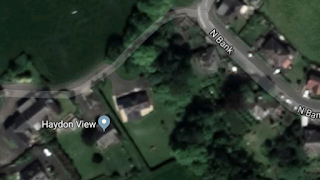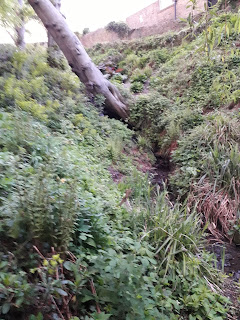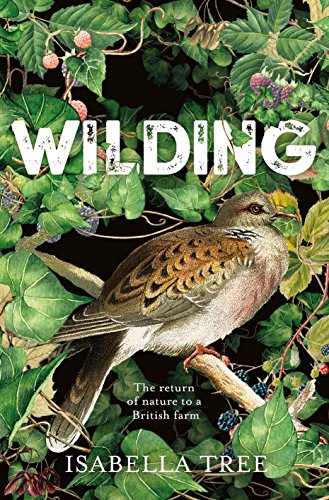 |
View of the dene from under the very large ash in the
farmer's field to the south of the property. |
How old is the dene and what were its possible prior uses?
In order to discover, I have turned detective.
The first bit was to do a brief survey of the trees in the dene – starting at
the kissing gate to the footpath and moving upwards towards my section. Below
the kissing gate is farm land, mostly run to sheep or occasionally cows. There
are some remnants of trees by the stream but I decided it would not offer any
real clues. The ash tree is huge there and must have stood the test of time, rough guess it has about 400 inch girth or so and at one point was heavily coppiced but hasn't been for a long time.
 |
| Banked earth by the kissing gate's dry stone wall |
However, by the kissing gate, I can detect banked earth – in
other words, as Rackham predicted there is a bank separating the woods from the
arable field. There is also a stone wall which marks out the wooded area enclosing it to the west,
including the footpath and seperating it from the arable field (and houses). Again Rackham
suggested that this is entirely what one would expect with an older wood which
may have been exploited at certain points.
So it would seem to be the ghost of an ancient wood which
developed into a boundary or hedge.
It was not profitable to farm down the dene,
but I suspect the trees were exploited in some fashion and many show signs of
coppicing which ceased many years ago. Most woods used to be exploited in some fashion, according to Rackham.
 |
| The kissing gate leading into the footpath. |
On the house side of the dene are the remains of a hedge –
the hawthorn, and several holly bushes. To see if my guess was accurate,
I turned to the 1862
OS Map of Haydon Bridge:
https://maps.nls.uk/view/102346473 In common with older OS every feature is
shown and this is before the house was built in 1908 so it gives some
indication of land use.
The dene is
clearly marked as a wood and there is clearly a footpath marked through it.
Looking at the deeds, the house side of the dene belonged to
Broom Hill farm at this time and was used as farm land ( I presume livestock).
The land to the east and west was owned by the Greenwich Hospital. As an aside,
this means it was the Earls of Derwentwater land which was sequestered after
the failed Jacobite Rebellion. The Earl of Derwentwater supported Bonnie Prince
Charlie and became the last noble to be executed for treason by the crown. I have no idea when Broom Hill farm became
separate from the Earls of Derwentwater land. However it was long enough ago
for a footpath to develop and to demarcated by a stone wall on one side.
The name of the house to the south of us which was built in 1902 is Hedgeley and that probably indicates that the dene and its trees were indeed used as a hedge. the suffix -ley normally means a glade within a wood in Anglo Saxon. Going from the OS map, I assume it was named when built and the owners were creating a glade within the hedge. The Dene, the name of my house is self-explanatory and again features the land.
The trees are mixed – Scot’s pine, sycamore, oak, ash,
hazel, willow, holly and lime. The Scots pine was probably plant/wind blown
sometime in the Victorian era. Sycamore again is mostly likely 18th century or later. The lime is interesting as there appears to be
three types – small leafed (pry) in the oldest part of the wood on the
footpath. Pry is nearly always an indicator of an ancient wood. There is also a
medium sized leaf lime (assuming common lime) – this is within Hedgeley
boundaries. And there is the large leaf limes in my section. As there used to
be an outcrop of limestone (assume there still is), it could explain the
presence of the trees. Alternatively persons unknown planted them awhile ago.
 |
| Footpath |
Near to the limes in my part of the dene, in early spring
there are white wood anemones. White wood anemones notoriously only grow in
ancient woods. They grow through underground runners and advance very slowly.
They also do not like being transplanted. It is only a tiny patch but it is clinging on.
I have no idea if Hedgeley has white
wood anemones or not. However there are
hedge plants such as stitchwort and green alknet.
We also have wild garlic growing in profusion – wild garlic
however can be transplanted. It is certainly though a plant which has gone wild
in the garden.
Some of our flowers only appeared after we made sure light
was getting into the dene – including the bluebells and the stitchwort. This
accords with Rackman’s assertion that regular coppicing allowed certain species
to colonise. Hedgeley with its closed canopy has slightly different flora. The
footpath is much more open and has a mix of species. The sheer mix of flora through
out the dene (I walked up the footpath, starting near the farm (no livestock in
the field) seems to indicate a longevity.
While I have nettles (sign of human disturbance), Hedgeley's dene and the footpath are remarkably clear of nettles. According to Rackham, true
wildwood doesn’t have nettles.
Further up beyond us is farmland where a disused dam
resides. It occasionally gets blocked with the odd sheep carcass. The
earthworks are huge though and it used to power the gin-gan of Peel Well Farm.
The stream probably always has been here, and they simply blocked it as it was
the best way to provide power. The stream also serves as run off from various
farms (we have had environmental incidents – most recently in April – all I can
do is report to the Environment Agency with photos).
It is also clear that my portion of the dene has been a
garden for some years, probably over a hundred years (the house was built in
1908). The nettles give it away and there are remains of paths and retaining
walls. The more formal part of the garden will have been farmland before the
house was built. I have no real idea of
how the Victorian plum tree is (around a hundred years?) but I suspect the back
lawn/orchard with wildflowers was at one point a productive orchard. It was
also probably a vegetable patch. We have a much smaller veg patch which is now
fenced to keep out the hens and ducks.
Where next?
I need to find out
about the outcrop of limestone and why it was considered to be of local
geological interest. It was in the late 1990’s that the geologist decided that
it couldn’t be seen. He seemed to think this would be better for us. I assumed
at the time, it would mean that it could not be exploited. But I suspect I need
to do more detective work here but I am starting to get an idea of how the dene
can be managed – get rid of/weaken invasive non-natives (ie ground elder) to
allow the native wild flora to flourish. The sticks do need to be left in situ
as much as possible.
 |
| The robin on the footpath. |
I also need to put the measuring tape around some of the
larger trees as that might help indicate when the wood really developed. My
daughter says that I mustn’t put a tape around large ash which is in the field
as it isn’t strictly on the footpath. (At 26, she still gets embarrassed by her
mother). It is a very large tree. However, I think I can find out a lot through
measuring the beech and large leaf lime which are in my portion. It is merely to discover if the trees were
here before the house. Given what I know
about the wood and the surrounding area, it makes no sense for anyone to create
an ornamental wood in the dene. There just were no major country houses in the
area. The nearest was Langley Castle and that was a ruin during the period of
major parkland creation and again it is too far away for that sort of activity
to make any sense.
But I have having fun doing the detective work and thinking
about the what used to be here and therefore what do the organisms in the soil
(the roots if you will pardon the pun of the ecosystem) want to support?
On my walk up the dene, I noticed a robin (hopping in front
of me as if to make sure I had filled in all the forms correctly) as well as specked wood butterflies. It is the
stopping and looking which has me noticing these things and that has to be a
good thing.




































